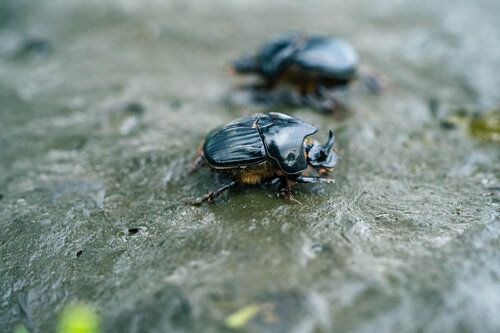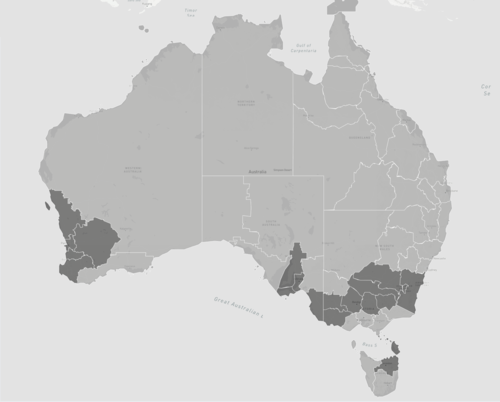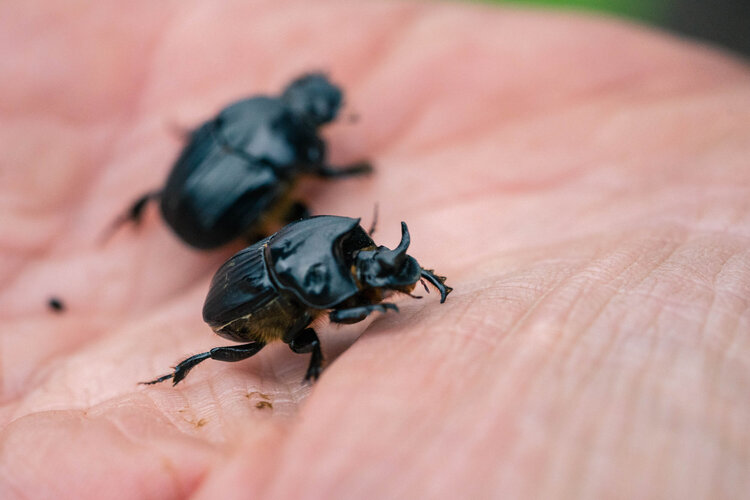Meet the beetle: Bubas bison
This distinctive looking winter-active dung beetle has fantastic potential for improving pastures in southern Australia. It was introduced to southern Australia from Europe by CSIRO and first released in Western Australia in 1983, where it took about a decade to become widely distributed. This was partly due to natural spread and partly due to field-cropping and release in different locations. By 1995, about 33,000 Bubas bison had been redistributed to 58 locations in southwestern WA. Since then, starter colonies of this beetle have been released in all southern states and New South Wales. Many hundreds of thousands have been field-cropped and released and this, combined with natural spread, has seen B. bison become well established in many locations across southern Australia. However, B. bison appears still to be absent from significant areas within its potential range. Part of the DBEE project is to assess the suitability of these areas for B. bison and, where suitable environments are found, the gaps can be filled by redistributing beetles from other regions.
Since 2003, Dung Beetle Solutions International (DBSI) has extensively studied the impact of B. bison on soil health, pasture production, carbon sequestration and water quality.
Bubas bison
Bubas bison is medium sized (13–19 mm) and shiny black. The long horns on the large males make B. bison very distinctive and photogenic. B. bison brood masses (buried dung containing eggs or larvae) are usually found at 40–60 cm below the soil surface. Like its close relative B. bubalus, B. bison lays two eggs in each brood mass. In favourable conditions, the beetle uses about 100 grams of fresh dung to provide food for one larva to develop to maturity. B. bison flies at dusk and dawn and colonises fresh dung pads (1–2 days old). When abundant, the beetles will quickly remove whole dung pads and bring a significant amount of subsoil to the surface.
LIFE CYCLE
B. bison can have a 1- , 2- or 3-year life cycle. Adult B. bison emerge in late autumn. They feed and mate in shallow tunnels (5–10 cm deep) beneath dung pads, then lay eggs in brood masses in deep tunnels (25–60 cm deep). During the life of an adult beetle a series of dung pads are colonised in which up to 50 eggs are deposited before the beetle dies, usually in late spring. Eggs laid in winter hatch in spring and grow through three larval stages (instars), becoming mature third-instar larvae by mid-summer. The larvae remain underground through summer and in most regions emerge the following autumn. In colder regions some larvae enter a form of arrested development (termed diapause) in which third instar larvae fail to transform into adult beetles in the first year but remain largely dormant for a period of time, emerging as adult beetles in the autumn one or two years later.
ESTABLISHING B. BISON IN NEW AREAS
Surveys are required to determine the extent of the distribution of B. bison across southern Australia. Where there is a gap in their distribution, a decision needs to be made as to whether the beetle will establish in that area. If an identified gap is surrounded by colonised country, it is likely that introducing the species (field cropped elsewhere) will close that gap. Where the species is absent over a wider region, it is necessary to assess whether it will survive and prosper in that region before introducing starter colonies. This can be done by assessing the breeding performance of the beetles in small field cages. If they breed well, introducing new starter colonies is warranted. If the beetles fail to breed successfully, then we need to determine why. For example, is the target region unsuitable, possibly because it is too wet or too dry?
Soil type appears to be a critical factor in determining whether B. bison breeds successfully. It prospers in many clay and loamy soils but not in deep sand. Waterlogged winter soils can be tolerated by the beetle in most circumstances, but irrigation in spring and summer can seriously reduce survival in some situations. The potential distribution of B. bison into irrigated dairy country in southern Australia is worthy of close scrutiny.
DUNG BURIAL IMPROVES SOILS
B. bison is a member of a group of deep-tunnelling dung beetles which play a special role in agriculture and the environment. Because they tunnel into the subsoil, they bury dung deep in the soil profile and at the same time bring a lot of subsoil to the surface. The deep tunnels facilitate movement of moisture and plant roots into the subsoil, where beetle activity raises the levels of nutrients and moisture and creates favourable conditions for plant roots. The subsoil brought to the surface also improves the fertility of surface soils. Dung burial also removes the pasture-smothering effects of surface dung and reduces movement of plant nutrients found in dung (e.g. phosphates and nitrates) into local waterways by water run-off. One experiment in the Adelaide Hills found that three months after complete dung burial, pollution in run-off water from fields was virtually eliminated.
THE FUTURE FOR B. BISON AND DBEE
Over the next few years DBEE intends to map gaps in the distribution of B. bison in southern Australia and fill appropriate gaps with field-cropped beetles.
In addition, there are a number of school-based projects that are testing the suitability of their local environment for B. bison and attempting to mass rear them for local release. The experience gained in these activities makes students well placed to participate in the rearing and release of new species that DBEE is bringing into Australia.


